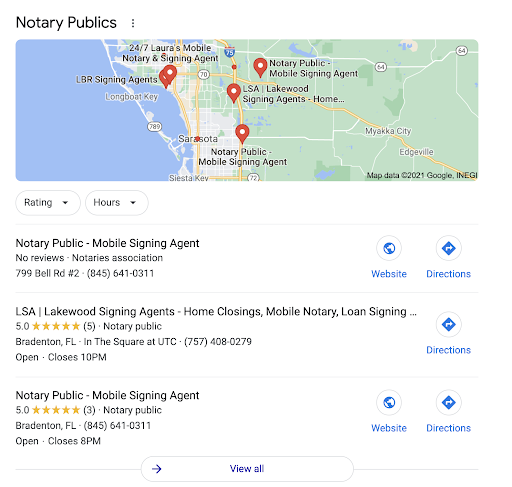
Amanda Farrell - 2 years ago

It’s not easy to build a successful notary business. It doesn’t happen overnight, and you’ll have to be prepared to do lots of research, network at in-person events, and make a lot of cold calls in the beginning. In addition to these traditional outbound sales and marketing activities, you’ll want to think about your digital marketing strategy.
Here are some tips to help you leverage social media, online directories, and search engines to market your business effectively.
The best way for people to find your business online is to create a business page. Whether it’s social media platforms like Facebook, a directory resource like Yelp, or a search engine like Google, each provides businesses with specific tools to drive brand awareness, customer engagement, and garner reviews.
For more information on how to set up a business page, click the links below. Each one is free to create.
Ideally, you’ll want to also set up a website too, but starting with these four will help your business rank higher in internet searches. They’ll also provide your potential clients with essential information like your availability, location, services, and a way to contact you.
Google is the most popular search engine, and 1.6 billion of those searches have “local intent” every day. That means that people are looking for local businesses to solve their problems. Google has created many special search features, like listings on Maps, to help users find the right services near them. Those who complete a Google My Business Profile will appear on local search results even without a website. Below is an example. The second notary signing agent listed has a Google My Business Profile but no website.

Another perk to setting up business pages on social media, Google, and Yelp is that you’ll be able to use the advertising and analytics tools. This information will be beneficial if you decide to advertise your business.
If you have a website, be sure to follow each platform’s instructions on adding tracking analytics codes. Facebook has the Pixel, LinkedIn uses the Insight Tag, and Google Analytics is a must for every website.
Yelp tracks traffic to websites based on the ad campaign, which will only become relevant if you decide to put ad spend behind your business on that site.
Adding tracking codes to your websites means you’ll be able to:
A notary doesn’t necessarily need a website to succeed, but it’s a valuable tool in today’s digital world. If you’re just starting out in general notary work, it might not be a suitable investment now, but if you plan to expand your business into loan signings, you’ll want to have a space carved on the internet to discuss the value you bring to your clients.
Once you have a website set up, analytics provides vital insight into your visitors and their behaviors. Of course, you didn’t become a notary to develop websites. I suggest using a website builder like Squarespace. You’ll find tons of sleek template designs optimized for selling services online. There are also built-in web analytics tools so that you can track key performance metrics like visits, conversions, and revenue per visit.
The number of active Facebook users grows every quarter. Right now, that’s roughly 2.89 billion people! Chances are, your perfect customer is there too.
Before you publish your first post:
For notary signing agents, there are several real estate professionals to know. If your goal is to increase bookings with these professionals, you’ll want to understand their challenges and provide content to help them overcome them. Share articles and videos that discuss those issues and provide solutions. If you have time to develop some blog content for your site to demonstrate how your services address their pain points, this is a great way to boost your website’s organic traffic. It’s also perfect for sharing on social media.
In social media marketing, there is something called the 4-1-1 rule. This rule suggests that businesses post four pieces of “new” content (your blog posts or articles from another source that you didn’t find on social), one reshared post from another company, and one self-promotion post.
This rule helps companies create helpful and educational content for their audience that social media platforms tend to prefer while still leaving plenty of room for self-serving content.
When creating a posting schedule for social media, there are several factors that affect a post’s reach:
In the beginning, you’ll want to experiment with the frequency and timing of posts. The analytics in each social media platform will help you understand what posts are performing well. In addition to the time and frequency, the kind of content you share will also impact the post’s success. Videos and images consistently outperform posts with linked articles on Facebook.
Most studies show that once per day is optimal for Facebook, with a maximum of two posts per day. The recommended minimum is three times per week.
For LinkedIn, no more than once a day and a bare minimum of twice a week.
You can also create posts on your Google My Business page. These will show up in the search engine results when your company name is searched.
Once you have an idea of the best times to post, use a free social media scheduler to help you plan out all the posts for a week and stick with it.
Social media is the place to have fun. People connect with authenticity, so don’t be afraid to let your personality shine. Look for inspiration from brands outside of your industry; you don’t have to do what other notaries do.
Balance the fun with a website and Google My Business page that conveys why people should use your notary services.
As you grow your online following and website traffic, leverage analytics to better understand who your customers are and what they love most about your business. With that information in hand, you can create even better content to boost your pages.
You may find success on other social media platforms like TikTok or Twitter. You may see your business goals shift based on your results too. Digital marketing is an ongoing process, so be open to changing it up!

This content is provided for informational purposes only. PropLogix, LLC (PLX) is not a law firm; this content is not intended as legal advice and may not be relied upon as such. PLX makes no representations as to the accuracy, reliability, or completeness of this content. PLX may reference or incorporate information from third-party sources, upon which a citation or a website URL shall be provided for such source. PLX does not endorse any third party or its products or services. Any comments referencing or responding to this content may be removed in the sole discretion of PLX.